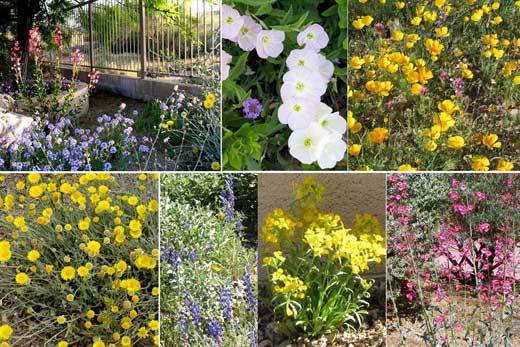BY LYNN WALSH | OCTOBER 19, 2011

Growing Wildflowers in the Sonoran Desert
Tips for growing Sonoran wildflowers in your garden
 Wildflowers in the backyard; clockwise from top left: Penstemon & Verbena; Mexican Evening Primrose; Mexican Gold Poppy & Owl’s Clover; Parry’s Penstemon; Western Wallflower; Lupine; Desert Marigold. Photos by Dave Mills
Wildflowers in the backyard; clockwise from top left: Penstemon & Verbena; Mexican Evening Primrose; Mexican Gold Poppy & Owl’s Clover; Parry’s Penstemon; Western Wallflower; Lupine; Desert Marigold. Photos by Dave Mills
This article first appeared in November 1998. Since there have been many newcomers to the Desert Foothills in the intervening period, we hope the information, slightly updated, is again welcome.
Nature evolved desert plants with unique characteristics to survive and thrive in our desert. A wet winter can result in a spectacular natural wildflower display the following spring. The right mix of temperatures and regular watering magically awaken and nurture long dormant wildflower seeds.
Michelle Rauscher, the horticulturist in charge of the desert wildflower beds at the Phoenix Botanical Garden, generously shared with me her experiences using nursery industry expertise with fertilizers, chemicals, and traditional gardening techniques. These practices worked against her goal of wildflower propagation. Like many new desert gardeners, she learned the hard way that disturbing the desert’s fragile crust by tilling the soil before sowing seeds stimulated dormant weed seeds to burst forth and outcompete her wildflowers. Instead of delightful wildflower beds, she had fields of the most invasive and aggressive weeds. It took her about five years of weeding by hand to finally eradicate those prolific weeds. (A weed is any plant that grows where you do not want it.)
Another miscalculation involved using fertilizers that resulted in very large, very green plants that produced very few blooms. Many common nursery practices were developed to grow exotic plants not native to our desert soil.
Mid-October on through early December is the best time to seed for our spring desert flowers. Tilling the soil is necessary only if the ground has been compacted such as when construction vehicles drive over it. Michelle lightly rakes or crumbles about one inch of the ground so that the seeds can get into the soil. She does recommend leveling the bed so that seeds grow evenly and don’t puddle with watering. She just presses the seeds in. She does not dig or bury the seeds. She tries to imitate nature.
Most desert wildflower seeds are very small so she mixes them with sand (or soil) in a container she marks with a halfway indicator so all the seeds don’t end up in one area. She suggests sowing seeds in your already irrigated areas. It’s less expensive and less work. Look for the wet areas in your drip irrigation and sow the seeds there.
The key to successful germination is to keep the soil moist until the seedlings emerge. How often to water depends on many factors including soil content, sun exposure, temperature, rainfall, etc. She recommends monitoring each location. Some may need sprinkling twice a day, others once every two days.
Another key factor is to protect seeds and seedlings from being the local wildlife grocery store. Chicken wire enclosures with bird netting (sometimes called tree netting) on top need to be secured tightly so that our curious Cactus Wrens, etc., can’t be caught inside the enclosed area. Don’t bunch the netting on the ground where it’s like a magnet for lizards and snakes who cannot escape becoming entangled in it. The white frost cloth that lets sunshine in also is a good alternative.
One of our Desert Awareness Committee members grows great wildflowers by dropping selected seeds in her clumps of bursage. These wonderful plants that act as key nurse plants to saguaro also protect penstemon and other flowers while providing a bit more organic matter at the base.
A beautiful wildflower bed is a joy to experience. But it takes a lot of work until established. Michelle cautions that it takes three to five years to establish a field of wildflowers and it takes a lot of hand thinning and weeding. She recommends starting a small area close to where you relax in your garden. Pick out some good perennials (plants that grow and bloom for more than one year) and make them your mainstay so that every year you’ll have brilliant blooms. Pick some with foliage that remains attractive all year.
Look to nature and your own neighborhood to see what grows where. The Desert Botanical Garden has many great demonstration beds and a huge new desert wildflower interpretative garden with many shrubs that you can view throughout the year to see what the seasons can show. Copy nature: ask neighbors for seeds from plants you like. Join Desert Awareness Committee members for our annual spring wildflower walk. Research and understand what you are bringing into the ecosystem. Select seed packets of Sonoran wildflowers native to our area. Michelle prefers to mix her seed selections herself instead of using packaged mixes. She urges home gardeners to collect and save seeds for next year. Cutting off dead plants at their base instead of pulling them up is another tip. And please don’t use a hoe or next year you’ll have twice as many weeds.
Remember late fall (starting mid-October) is the time to spray with a pre-emergent weed stopper any area where you have problems with weeds and are not going to sow seeds. It’s good fire insurance for next summer. Our Sonoran desert is wonderful. Do your part to preserve and enhance our fragile beauty, and may our springtime be filled with beautiful native wildflowers.






